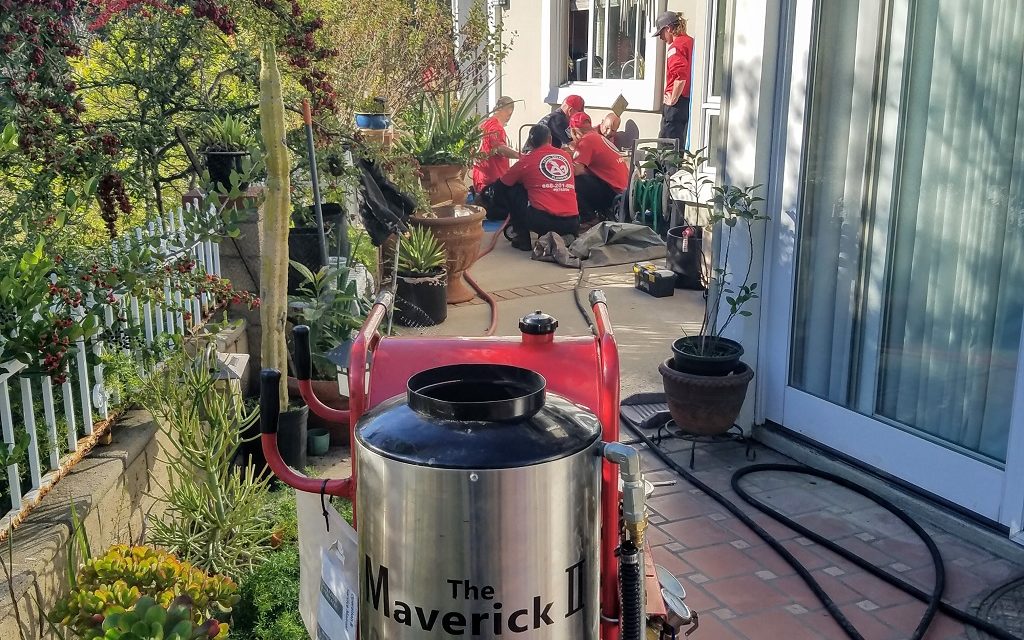In Part 3 of our experience addressing issues with our home sewer line, we finally get to the good stuff of final remediation – at last! In this follow-up article, we share all of the details we learned about CIPP, a revolutionary, non-invasive solution for home sewer line repair.
Table Contents
- Recap of Part 1 & 2 of Our Home Sewer Line Experience
- About Our Vendor: A1 Total Service Plumbing
- Preparation for the Repair
- Steps to CIPP Resolution
- Lessons Learned
- Trenchless Repair Resource Links
- Recommended Reading
Recap Part 1 & 2 of Our Home Sewer Line Experience
To understand our approach of how we diagnosed our plumbing situation, weighed remediation options, and vetted competing bids & contractors, be sure to read Part 1 and Part 2 of our story:
- Part 1: Non-Invasive Plumbing Tech for Repairing Your Home’s Sewer Line
- Part 2: Non-Invasive Plumbing Tech: Bids, Proposals & Lessons Learned
In Part 1, we explained how we diagnosed our situation, temporarily mitigated the circumstances, and educated ourselves on possible permanent remedies.
In Part 2, we took our readers through the bidding process, the remediatation method we chose, and the reasons we selected the contractor we eventually chose.
About Our Vendor: A1 Total Service Plumbing
In Part 2, we explained how and why we chose A1 Total Service Plumbing (A1TSP) to fix our home sewer line, referred to as Contractor #4 in the article. We first learned of A1TSP while researching Waterline Renewal Technologies’ suite of companies and technology solutions. Included on Waterline’s website is a directory of trenchless sewer line repair companies, consisting of firms certified in Waterline’s family of technologies and products.
As we considered repair options, including traditional trench methods, we were adamant that we would not select a vendor until speaking with a trenchless expert like A1TSP. We approached trenchless repair with an open mind, as we understood upfront that for some situations (e.g. narrow piping with several sharp turns), trenchless repair may not be a viable option.
We also learned that plumbers without extensive trenchless experience can be prone to overstating the risks of CIPP solutions, and will steer customers to their comfort zone of traditional plumbing repair (e.g. digging up floors, concrete and dirt, to install new piping). In short, we were very confident in our choice of A1TSP and going the CIPP route for remediation.
A1 Total Service Plumbing is based in Los Angeles, California, and has been in business since 2004. More than just a trenchless specialist, the firm offers a wide range of plumbing services for residential, commercial and industrial properties, including:
- High-Tech Pipe Relining (Pipe Bursting, CIPP & Epoxy Spraying)
- Trenchless Pipe Replacement
- Video Pipe Inspections
- Drain & Pipe Cleaning/Hydo Jetting
- Pipe Descaling
- Drain and Sewer Repairs
- Traditional Pipe Replacement
- Installations
- Copper and Pex Repiping
- Septic Plumbing
- Ground Penetrating Radar
- Water and Gas Leak Detections
- Tankless Water Heaters
Also unique to A1TSP is their one-of-a-kind CEO and founder Raymond Gray. He is a fourth generation pipe fitter and plumber, and a summa cum laude “graduate” of the school of hard knocks. To get more familiar with Raymond’s colorful personality, his motivation for providing best-in-class service, and his overall approach to innovation and leadership, we highly recommend watching an in-depth interview with him hosted by It Happened on the Job. You will get a further taste of A1TSP’s corporate culture as we share more about our experience in this article.
Also worthy of mention is A1 Total Service Plumbing’s commitment to the Military community, including active duty, reservists, veterans and retirees. Specifically, A1TSP offers free drain cleanings on RED Fridays to the first 10 Military respondents for either home or business, as a way of thanking brave Military personnel. RED is an acronym for “Remember Everyone Deployed”.
A1TSP’s RED Friday Free Drain Cleaning Promotion
Preparation for the Repair
So, the big kickoff for our sewer lining remediation project had finally arrived on Thursday. Not sure what would be our allowable utility during the day, we decided to wash a load of laundry at 5:30AM, just in case we were left without some plumbing functions as the work progressed.
As the final spin started, around 7AM, we looked out the bedroom window toward the patio below, and noticed that the cleanout below the kitchen drain was covered in water. How could this be happening?
Since the analysis and diagnostic phase, we had completed four loads of laundry without incident. The architecture of our plumbing suggested that the laundry room plumbing, located on a second level, drained directly to the main line in the garage and out to city sewer. What did we miss?
Our plumbing team from A1 Total Service Plumbing (A1TSP) arrived later that morning and we explained what we observed during the laundry spin cycle. Immediately, our Project Manager, Mario, gathered up his tools to begin scoping the drain lines once again.
Armed with a Ridgid SeeSnake microREEL Video Inspection System, Mario once again tested each plumbing fixture one by one, including the washing machine. All fixtures drained to the main sewer line. However, the washing machine, drained further up the main sewer line than that of the guest bathroom.
Further inspection revealed that buildup within the main line caused a back-up of washing machine drain water to back flow to the cleanout onto the patio. Since the laundry room connects with the main sewer line further upstream, scale and corrosion on the inner pipe walls resulted in constriction of waterflow out toward the patio through the cleanout.
Corrosion deposits form naturally over time, in cast iron piping, and attach to the inner walls in a process known as tuberculation. This is similar to occlusions that happen in the human body when plaque adheres to artery walls, thereby restricting blood flow. This descaling of the main line is now on our upcoming maintenance schedule.
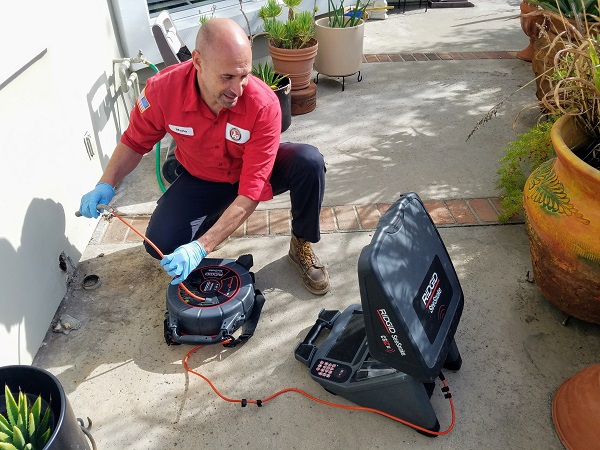
Steps to CIPP Resolution
As we mentioned in Part 2, we chose to use CIPP (Cured In-Place Pipe Lining) to correct our defective 2” kitchen sewer line. An important point here, is that in terms of CIPP, narrow 2” piping does present more challenges and risks. However, true trenchless experts, like A1TSP, know how to mitigate these risks and produce a high-quality, reliable outcome.
Here are the steps that were involved with our 2” CIPP pipe relining:
- Step 1: Low Dig
- Step 2: Cleaning & Descaling
- Step 3: Preparation of Materials & Inspection
- Step 4: Liner Insertion
- Step 5: Curing with the Calibration Tube
- Step 6: Fixing Anomalies
- Step 7: Final Patching
Step 1: Low Dig
Though the trenchless industry likes to use provocative descriptions like “zero dig” and “no dig” to describe their non-invasive solutions, some digging and cutting of walls will likely be necessary. To be fair, however, this work is minuscule in terms of traditional trench methods, so we do not believe a “no dig” description is misleading.
A 3′ x 2′ foot section of stucco and concrete, surrounding the drain cleanout, was removed to create an access area to the 2″ drain line from the kitchen. Once this part of the sewer line was exposed, the corroded, cast iron section of the drain was replaced with new ABS pipe and a new cleanout cap. This provided a stable entrance for the next steps, cleaning and descaling of the pipe lines, through to the 3″ main sewer line.
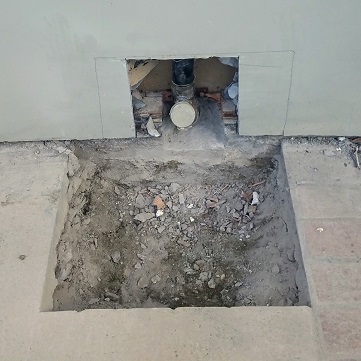
Step 2: Cleaning & Descaling
Descaling and cleaning of over 17 feet of pipe and hydrojetting of over 50 feet proceeded to take most of the day Monday, as the lining crew prepped the sewer line for the CIPP procedure that would begin the next day. The descaling process is critical to ensure that the epoxy-laden liner to be inserted can form a large and smooth surface with the inside of the existing piping.
The crew ended the day by taking a video image of the length of piping to be lined, to allow tomorrow’s crew to review the work. This insures that the next crew is presented with a well prepared pipe for the lining process.
Step 3: Preparation of Materials & Inspection
On Tuesday, the impressive big truck arrived fortified with equipment that looked as if they had planned to reline the entire neighborhood. As the crew, dressed in their professional A1TSP uniforms, embroidered with the individual technician’s name, unloaded their gear, they resembled professional soldiers about to enter battle.
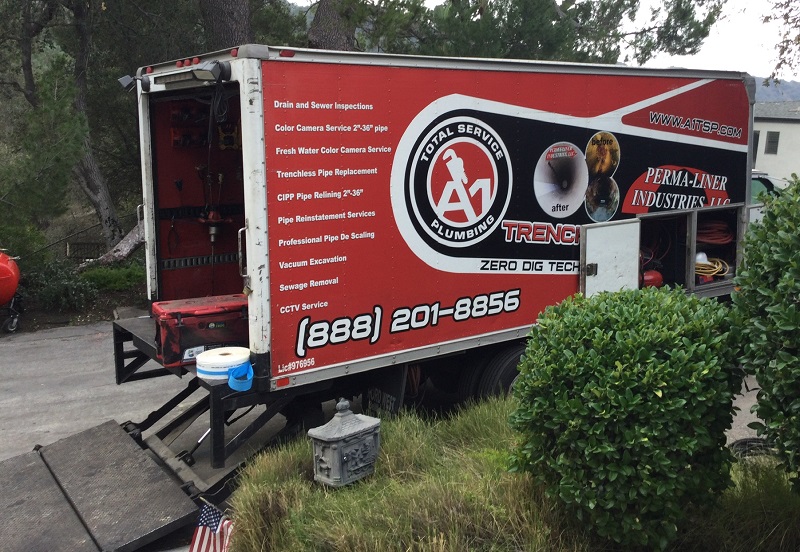
An interesting sidebar here: Gray shared with us how important it is for him that each member of his crew maintain a professional appearance while out in the field. In other words, they need to look, feel and act like professional tradesmen, and they need to be comfortable all the way down to the work boots on their feet.
Lengths of CIPP material known as Perma-Liner 2″ Super Flex Thin with Stitched Seam Felt were unrolled and measured to satisfy the approximately 17 feet of cast iron pipe to be lined. The liner comprises a polyurethane coated polyester felt with a stitched seam for easy inversion. Perma-Liner offers a complete line of lining materials depending on the degree of angles – 22, 45 and 90 – that must be negotiated during the lining process.
A two part epoxy resin is prepared that when mixed together will harden to form the inner lining of the turgid sewer pipe after a curing period. The mixture is a catalyst and a hardener, or an A side resin and a B side resin, (usually in a 2:1 ratio). Depending on the ambient temperature of the project a different blend is used.
Pro Tip: Mixing and using the proper epoxy for the given ambient temperature is another area where less experienced professionals may make mistakes.
The combined mixture is then funneled into the liner and sealed with masking tape on one end and a vacuum head on the other. The liner is then placed on a roller and calibrated to evenly distribute the resin mixture within the liner, a process known as saturation. During this process the saturation of the liner is evident as the vacuum of the calibrator, coupled with the rollers, pulls the resin into the liner’s internal felt material.
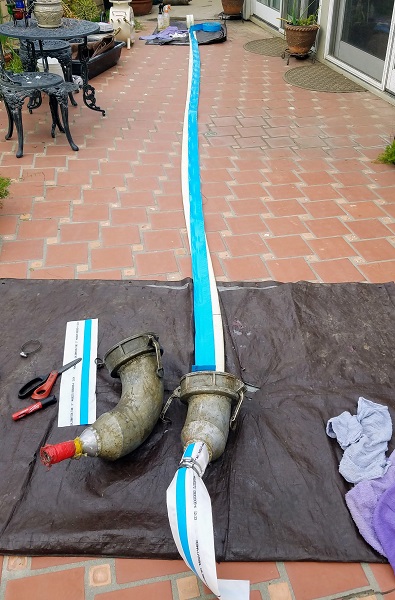
Step 4: Liner Insertion
The liner is now ready to be inserted. The masking tape is removed from one end and sealed on the other end to provide back pressure during insertion. An industrial inverter machine is used to invert the coated liner as it moves through the sewer line to achieve this result. The liner is given a light spray-coating of a food grade lubricant to reduce friction during the inversion process, when the liner inverts upon itself.
The inversion head is installed onto the inversion drum to start the process as the apparatus is lined up with the opening of the old sewer pipe being repaired. During the inversion process the liner is guided with pull tape to help pull and guide the liner through the old pipe. In less than 30 seconds the liner is blown into place and ready to be cured by the calibration tube.
Step 5: Curing with the Calibration Tube
The calibration tube (“cal tube”) is then sent through the liner via either the inversion machine method or via push rod, to provide a two to three hour ambient curing process. The push rod is a flexible, metal rod, that allows the technician to gently guide the cal tube inside the liner to be inflated later to create pressure for adhesion to the old sewer pipe wall. The push rod is normally only used for smaller diameter pipes (e.g. 2″) as larger diameter pipes, from 3″ and up, use the inversion machine method for insertion.
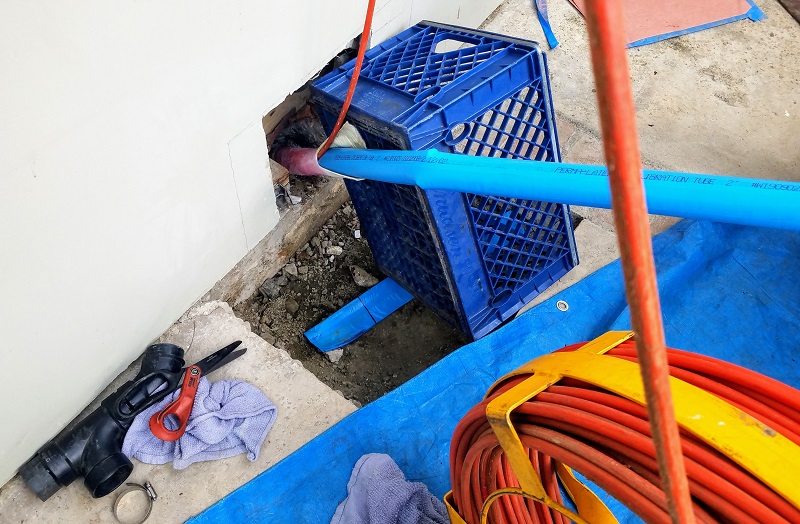
Depending on the liner size, anywhere from 5 PSI (pounds per square inch) to 10 PSI are regulated via the calibration tube at a steady, positive pressure. This process causes the cal tube to push against the liner to create the cylindrical form of the host sewer pipe. Since the setup is connected to a portable air tank, the new liner with the inflatable cal tube can be left to cure or harden for the requisite three hours. Occasional checks of the pressure gauges are necessary to make sure the proper air pressure is flowing during the curing period.
The key to quality curing is insuring that the liner seam, the poly threads that create the cylindrical shape of the liner, is effectively cured. A best practice used is to dye the epoxy mixture a distinct color from that of the white color of the liner and look for the dye color to be saturated within the seams. In A1TSP’s case, they dye their epoxy red, the brand color of their company.
An interesting sidebar here: Raymond Gray and his best-practices are so well known in the industry that when some trenchless professionals use a red dye they may sometimes joke that they are “channeling their inner Raymond Gray”!
Step 6: Fixing Anomalies
Ever the perfectionist, Gray wanted to return to fix a minor imperfection at the end of the 2” drain line caused by the end of the push rod, used to guide the cal tube in place. The process known as “hot bagging” was performed the next day to heat up the cured resin and smooth out any possible flaws or wrinkles which might cause obstructions to form in later years.
Hot bagging, also known as hot water lateral inversion, requires heating water to 180 to 200 degrees F and creating a closed loop system with a calibration tube inserted into the infirmed liner. Once the heated water passes through the tube enough times, the resin softens and the heated cal tube smooths out any wrinkles, indentations or malformations of the liner, which may have resulted during the original process.
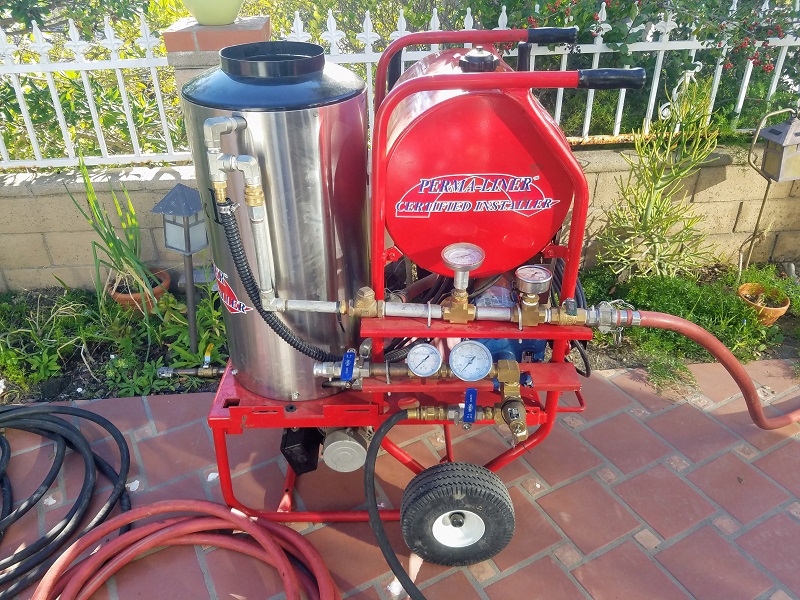
Step 7: Final Patching
The last step of the project was for A1TSP to patch the opened wall and replace the removed concrete. The only remaining task for us, the homeowners, is to paint the small section of repaired wall. We had this task confirmed in writing in A1TSP’s proposal, so we knew up front exactly what we would need to do to return our space back to normal.
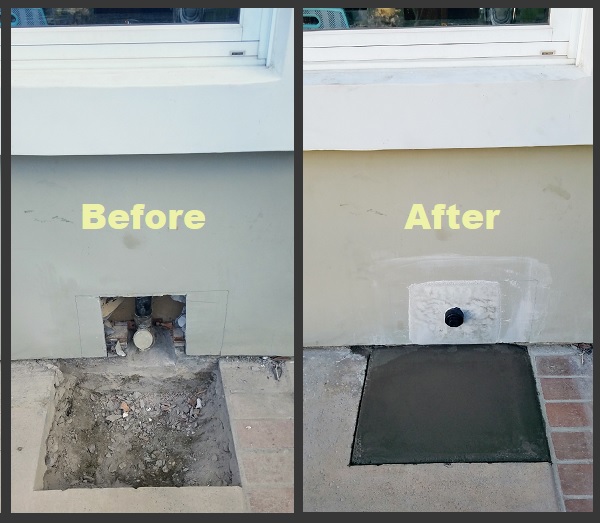
Lessons Learned
An overarching lesson that we learned is that the best trenchless professionals understand the many nuances of working with CIPP, including various pipe widths, ambient temperatures, post-install adjustments, pre- and post-inspections, etc. Those that are not experts working with CIPP, and other trenchless technologies, may dissuade homeowners from using a trenchless solution for your situation, based on faulty knowledge, lack of equipment or a bias towards longer, more expensive, traditional projects.
Additional Lessons Learned:
- Like most home improvement projects, being present on the jobsite, asking questions and being flexible, are always critical for achieving the best results possible
- Similar to quality contractors of all types, proactive communication and honest, thorough explanations are critical traits to look for in your plumber.
- Setbacks will inevitably happen, though less often with quality contractors. The best contractors do not shy from this reality and are able to handle challenges with the best interest of homeowners in mind.
- On the advice of A1TSP, we are putting ourselves on an annual inspection and cleaning program to keep our sewer lines in good health
- Sewer line inspections should be part of any home inspection when purchasing a new home
- Treat your sewer line, especially your kitchen drain, with respect – poor usage and maintenance will dramatically shorten the lifespan and flow-through of your piping – food oils, for example, can constrict the diameter of your kitchen drain
- When leveraging newer technologies, be sure to check the level of experience and knowledge of any contractor considered – specialists that are breaking new ground tend to be active members of industry communities to continue their learning and capabilities
- With trenchless solutions, quality contractors will thoroughly inspect each step of the process and make corrections, if and when necessary. You want to partner with professionals that are disciplined at getting the job done correctly upfront.
- When presented with the opportunity, be proactive and have your entire plumbing system inspected instead of waiting for the next disaster to happen.
Trenchless Repair Resource Links
- A-1 Total Service Plumbing
- Perma-Liner Trenchless Pipelining Solutions
- Verified & Certified Trenchless Sewer Repair Contractors
- Waterline Renewal Technologies
- Repipe Lining Systems
- Pipe Lining Supply
- RIDGID Tools
- Dancutter USA Pipe Rehab Robotics
- Trenchless Pipe Relining by H2O Maestro Plumbing
Recommended Reading
- Part 1: Non-Invasive Plumbing Tech for Repairing Your Home’s Sewer Line
- Part 2: Non-Invasive Plumbing Tech: Bids, Proposals & Lessons Learned
- Signs It May Be Time to Replace Your Piping
- How to Plan & Manage a Renovation Successfully
- Essential Elements of a Home Renovation Contract
- Why Prescriptive Maintenance is the Cure for Homeowner Headaches
- How to Choose a Qualified & Trustworthy Contractor
- How to Hire a Handyman Safely, Wisely & Virtually
- How to Increase Your Chances of Hiring a Good Contractor
- Signs of a Bad Contractor Before You Sign a Contract
| Purgula is reader-supported. When you click on links to other sites from our website, we may earn affiliate commissions, at no cost to you. If you find our content to be helpful, this is an easy way for you to support our mission. Thanks! Learn more. |

